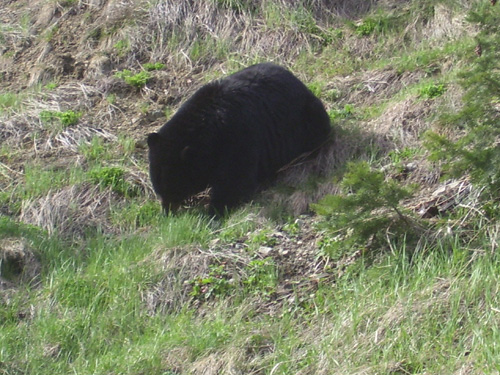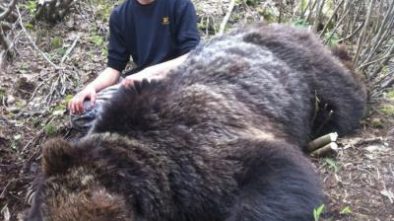Scouting For Bear Hunting
Scouting should precede bear hunting if the hunting trip is to be successful. Scouting is how you will find an area that has bear presence and determine your hunting area for the hunting season. When you obtain a bear hunting license, it allows you to hunt bear both on public and private land as well. In fact, the maximum numbers of bears are harvested on private property. However, you must obtain the landowner’s permission before you can hunt on private land.
Private landowners involved in dairy farming with extensive silage corn plantations and suffering bear damage to crops are interested in inviting bear hunters to hunt the pestering animals on their property. During the 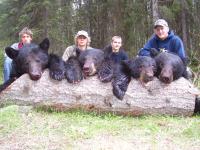 gaming season, authorities usually forward a list of licensed bear hunters to landowners in the bear hunting area(s) to facilitate joining interested landowners and hunters. However, it is in your interest not to wait that long, but to start scouting early by contacting private landowners instead of waiting for them to contact you.
gaming season, authorities usually forward a list of licensed bear hunters to landowners in the bear hunting area(s) to facilitate joining interested landowners and hunters. However, it is in your interest not to wait that long, but to start scouting early by contacting private landowners instead of waiting for them to contact you.
My hunting party reaps the rewards of scouting and knowing the location, by taking these bears in 24 hours.
A landowner can greatly reduce your scouting efforts as he can provide you with reliable information about the daily or periodic movement of bears on his property. He is the best source of information about the places where the bear’s natural food sources are available on the land and about the vegetation, cover and topography. You can greatly increase the chance of your success in bear hunting through increased scouting in your hunting area.
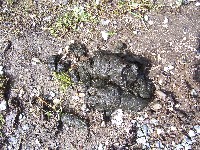 During pre-season bear scouting, you must make a careful note of the places that provide food sources for bears. While scouting on public land, concentrate your scouting efforts on areas that have an abundance of natural bear food like grass, clover, beech, acorns, and cherries including other hard mast, nuts and berries. Bears also relish fruits like apples, black cherries etc. This is a time when the bear strongly acts to the pangs of hunger. The bear spends nearly all its time feeding to fortify itself for the following months of inactivity i.e. winter hibernation, when there will be no feeding. Whenever these sources are scarce, bears travel long distances to get to orchards or cornfields in order to get food they like.
During pre-season bear scouting, you must make a careful note of the places that provide food sources for bears. While scouting on public land, concentrate your scouting efforts on areas that have an abundance of natural bear food like grass, clover, beech, acorns, and cherries including other hard mast, nuts and berries. Bears also relish fruits like apples, black cherries etc. This is a time when the bear strongly acts to the pangs of hunger. The bear spends nearly all its time feeding to fortify itself for the following months of inactivity i.e. winter hibernation, when there will be no feeding. Whenever these sources are scarce, bears travel long distances to get to orchards or cornfields in order to get food they like.
Bear feeding areas are more likely to be close to streams, ponds or other water sources providing plentiful water. Due to their large size, bears cannot sustain themselves from the moisture in their food and need to drink water from sources nearby. Bears frequent water sources surrounded by dense forest cover like mountain laurel or rhododendron thickets. Game scouting cameras placed at such locations can yield reliable pictures/video clips of bear movement within the camera field to confirm their presence and size. This information can also help in deciding where to set up your bait stations.
Being large and clumsy bears leave unmistakable signs of their presence. Signs to look for would be bear scat, footprints or tracks and claw marks they leave while scaling trees. Marks on tree trunks at heights of six to eight feet are made deliberately as signs of territorial claim.
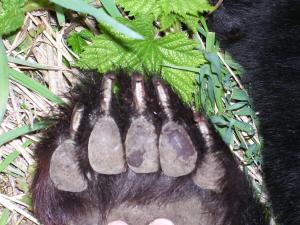
A picture of a black bear paw and claws.
A careful scrutiny of bear scat can provide a lot of information about the bear. In the first instance, it confirms its presence. Its abundance is an indication of its frenzied feeding for the coming winter months. During this time, the bear can defecate five to fifteen times a day depending on the food intake. Scats can be found deposited as piles or logs and the size of the animal can be gauged by looking at the scat. Small size bears produce logs diametrically comparable to ‘D’ size cells, whereas the scat of a large bear will be nearly as thick as a soda can.
The content of the scat can tell you about the feeding site of the bear. Bears that indulge in farm crop foraging will leave yellowish scat full of corn kernels. If the scat contains garbage and plastic wrappers etc. the bear is sure to have been reaching residential trash sites.
Bear tracks are unique in shape and are less prone to being mistaken for tracks made by other animals. The front paws leave marks similar to those made by a human hand having short stubby fingers with claw marks close to there paw print. The hind feet impressions are similar but have the fingers attached to a long heel. Sometimes the toes leave claw marks sometimes they do not. Size wise, a two hundred pound bear will leave tracks that are about four inches wide. Larger bears will leave larger tracks. Scouting is discussed in further detail on video in this black bear hunting instructional DVD.


